The Dwarf Date Palm
By Phil Bergman, Jungle Music
This Comprehensive article covers the native habitat, history, appearance, culture and care of the Pygmy Date Palm, Phoenix roebelenii, the Dwarf Date Palm
INTRODUCTION
Phoenix roebelenii, the Pygmy Date Palm
When one talks about a Date Tree or a Date Palm, he is talking about a group of palm trees that belong to the genus Phoenix. The Pygmy Date Palm is a species within this genus. It is also known as the Dwarf Date Palm. This palm has become very popular over the previous five decades and can be seen quite commonly in many areas throughout the world. It is used particularly in tropical and temperate areas in sunny locations. Its popularity is due to the fact that it is a shorter species, thus the term “Pygmy” implying “small”. In the United States it is known as a single trunk palm that is often sold with multiple plants put together into one container. But, in habitat it often suckers on its own. This has confused people because somewhere in cultivation it lost its ability to sucker and form multiple trunks. Nurserymen make up for this by planting typically three plants in one pot. Below we will discuss in detail all aspects of this attractive palm.
NATURAL HABITAT AND HISTORY
Phoenix palms can be found native to many areas of the world. Phoenix roebelenii, however, has its origins in Asia, specifically in Southern China. Laos and Vietnam. Perhaps its exact origin is in Laos. In these localities, the Pygmy dates grows in more humid areas and is often seen along river beds. In habitat, this species is often a suckering species with thinner trunks and sparse crowns. It was named after a 19th century botanist from plants collected in Laos. Fifty years ago it was thought that this species never got above six feet. I suspect this was because specimens in domestic gardens at that time had not had the time to get larger. Presently specimens can be found that are ten feet or taller.
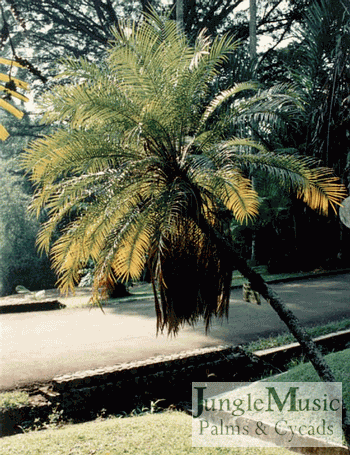
single, in a garden
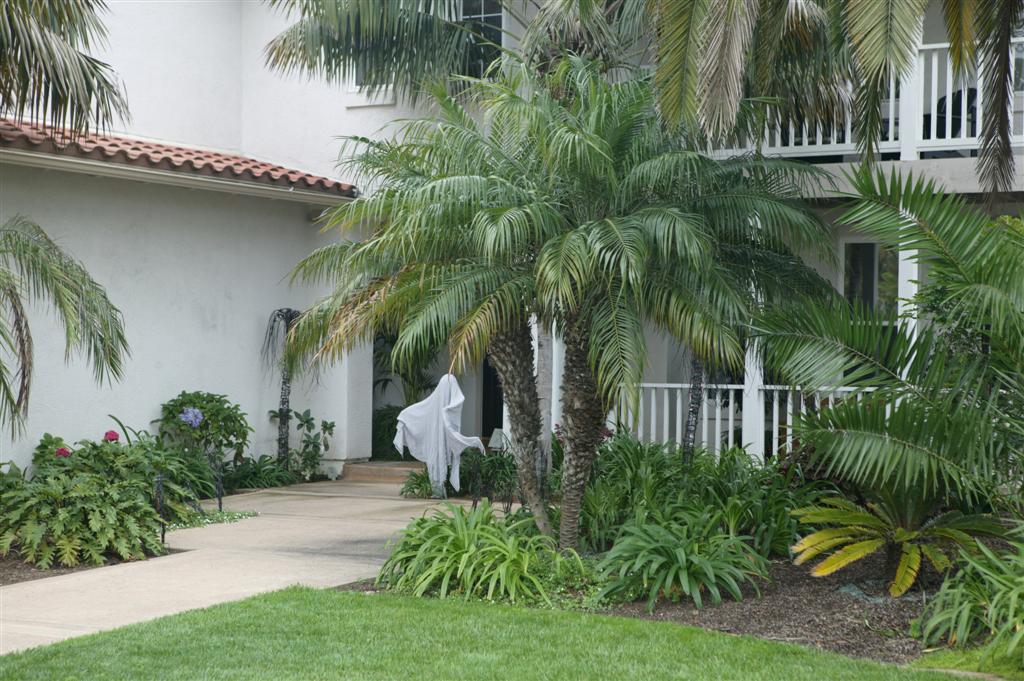
garden.
APPEARANCE AND MORPHOLOGY OF THE PYGMY DATE PALM
When old and mature, specimen Pygmy Date Palms are typically between six to ten feet in overall height. Pictures here show single trunk specimens, either as a single plant or a grouping of multiple plants. As mentioned above, several plants are often put into the same container to give the appearance that this dwarf date palm actually suckers. As mentioned above, this confuses people because in habitat it is often seen suckering. But, somewhere along its development as a commercial palm, this species has lost the ability to sucker. Seeds collected from wild habitats often do sucker, especially with seeds from Laos. Domestic seeds typically don’t sucker. But, the average plant you see in a nursery is a single trunk palm, often planted as a “multiple”.
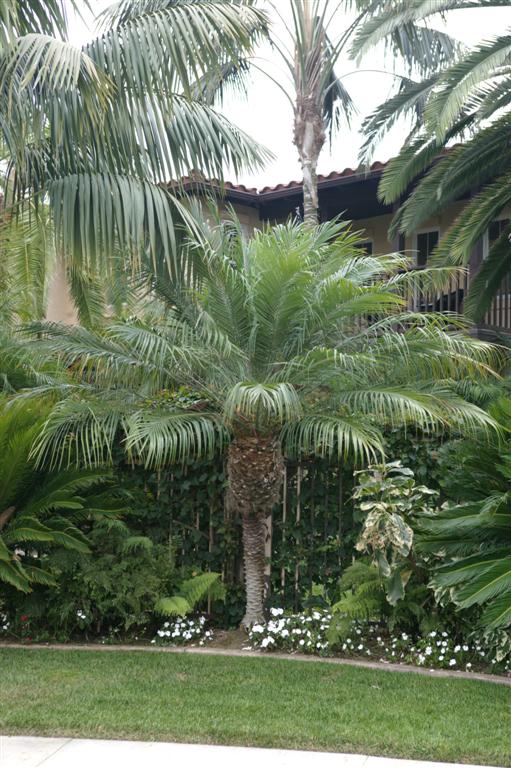
Pygmy Date Palm
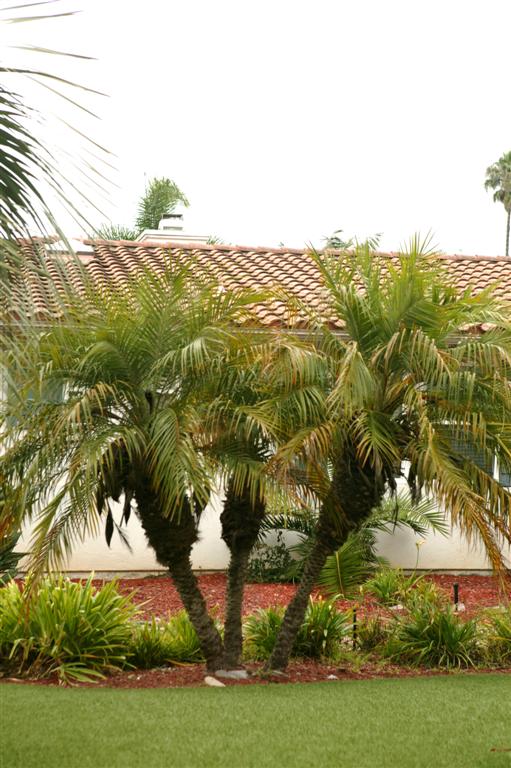
yard
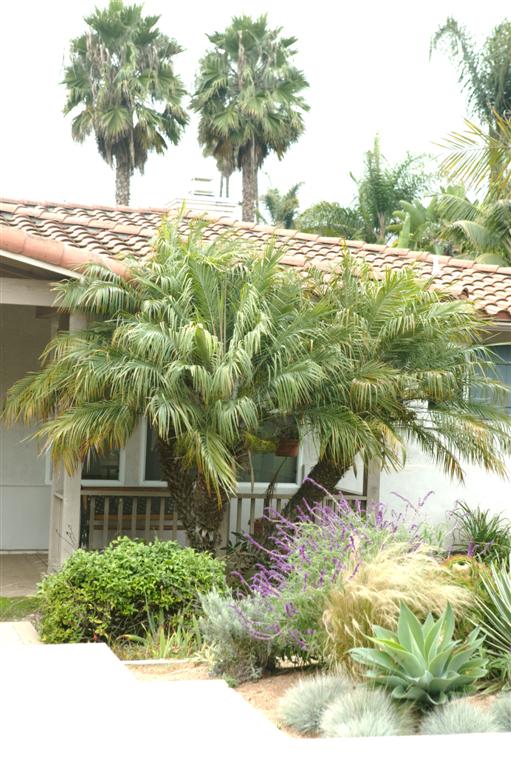
roebelenii
The trunks are quite thin, averaging three to six inches in diameter. They are typically thick with fibers right below the crown of leaves. With age and when old leaf base debris is removed, the trunks take on a bit of a “knobby” appearance with remnants of old proximal leaf bases. The trunks can be straight or somewhat curved. If planted at an angle, plants will eventually go upwards toward the sun. This gives them a curve in the stem. The upper trunk below the crown shows lots of retained leaf bases. It’s further down the trunk that the knobby appearance is seen when cleaned.
The leaves of the Dwarf Date Palm are typically three to five feet long on specimens. The leaflet color is typically glossy green, silver-green, or darker green when grown in filtered light. The crown is often described as “delicate”, “soft”, or “lush”. The overall crown is rounded with as many as thirty to fifty leaves. The leaf stems (petioles) are armed near their base with sharp spines that can be as long as three inches. Protective eyewear should be used when pruning or cleaning this species.


Being a dioeciously palm, any given Pygmy Palm is either a male or female. This means, that to set pure viable seeds, one must have both sexes in proximity. Insects will typically transfer male pollen to the female. If no male is around, hybrid seeds are often produced from pollen of other nearby Phoenix species. Flowers with seeds hang below the crown and can have several hundred seeds per blossom stem. Seeds change from green to black when mature and are typically one half inch or smaller in size.
HOW TO GROW PYGMY DATE PALMS
Phoenix roebelenii are fairly easy to grow. They survive well in tropical and temperate regions. In coastal areas with good humidity, this species prefers full sun. Further inland and in desert areas, they do best in filtered light or partial sun. Plants along the coast that are in dense shade tend to be lanky and perform poorly. They can even die in full shade. Therefore, it’s best to give them some exposure to sunlight. They like rich, good draining soil. Clay can be tolerated if not overwatered. Average watering schedule is three times a week although specimens can tolerate a bit of drought. With ample water, Pygmy Date Palms have a more lush, tropical appearance.
The Pygmy Date can be planted as a single stem specimen, and as a single will show more rapid growth than groupings of multiple plants. In other words, a single stem plant will put on height more quickly if there is less adjacent competition for nutrition. Most commonly, when purchased, the Pygmy Dates are in groups of three. They can show stair stepping in size, although this is not always seen. This means that one plant is tallest, one shortest, and one in the middle. The picture below shows three fairly matched plants.
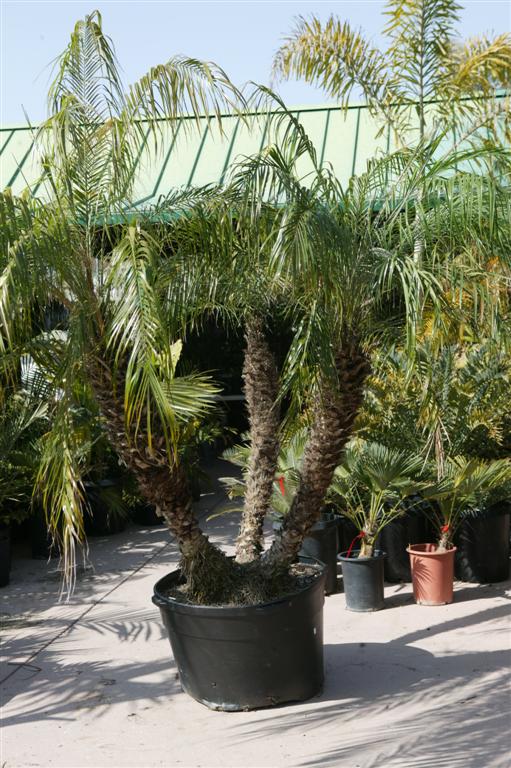
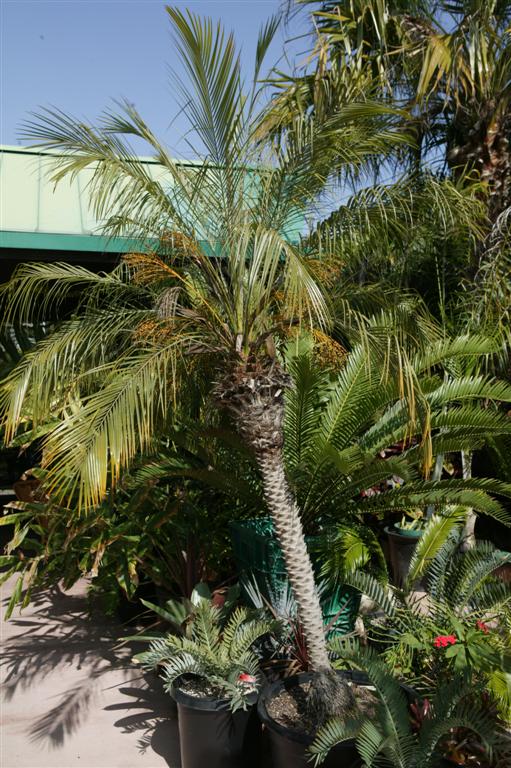
As this species is grown in huge numbers commercially, most plants sold at depot type stores are imported from more tropical regions where production is quicker. One might find locally grown specimens (from your locality) to be more vigorous after planting. Imported plants might also need acclimation to your sunlight. I have noted that plants brought in from tropical areas often have very thin trunks whereas plants grown locally here in Southern California have fatter, more robust trunks.
Growth rates of Pygmy Date Palms are slow to medium in speed. A small specimen of two feet height can obtain a height of six or more feet in five to seven years. Germination of seeds typically takes three to six months and gives a single blade of grass type seedling. Seedlings should be grown in filtered light until they are vigorous one gallon plants.
COLD TOLERANCE OF PYGMY DATE PALMS
There are many factors which affect cold tolerance of the Pygmy Date, but in general it is felt that this species tolerates temperatures down to the mid-twenties F or perhaps a bit lower. Temperatures in the teens will kill Pygmy Dates. If one lives in a colder climate, the Pygmy Date Palm is far from the most cold hardy Phoenix. In such a situation one should consider species such as Phoenix canariensis, Phoenix dactylifera, Phoenix theophrastii or almost any other species. These alternative species, however, don’t have that miniature size and charm of the Pygmy Date. On can cold protect this species to some degree by wrapping the crown with protective cloth or by other techniques. It is surprising that large chain stores continue to sell Dwarf Date Palms in localities where most likely they will die.
HYBRIDS WITH THE PYGMY DATE PALMAND SINGLE AND MULTIPLE TRUNK FORMS
As previously mentioned, the Pygmy Date Palm like all Phoenix species has a high tendency to hybridize with other species among the genus. Thus, one gets all sorts of offspring variations. Some feel this might even be one of the mechanisms whereby the Pygmy Date became a single trunk plant. Regarding hybrids, I have seen crosses between the Phoenix roebelenii and the huge Canary Island Palm. The offspring are a suckering plant with huge trunks as you would expect. Some feel that the common Pygmy Date propagated in Florida tends to have a more coarse and larger leaf than other “more pure” strains. This might represent hybridization. The bottom line is: if you collect seeds off your Pygmy Date Palm and didn’t control pollination, you’ll probably end up with a hybrid.
As mentioned above, in the wild the Pygmy Date is often seen as a suckering species. The photograph below shows a true suckering habit from seed collected in the wild in Laos. Not that the “sucker” is coming directly off the parent trunk.
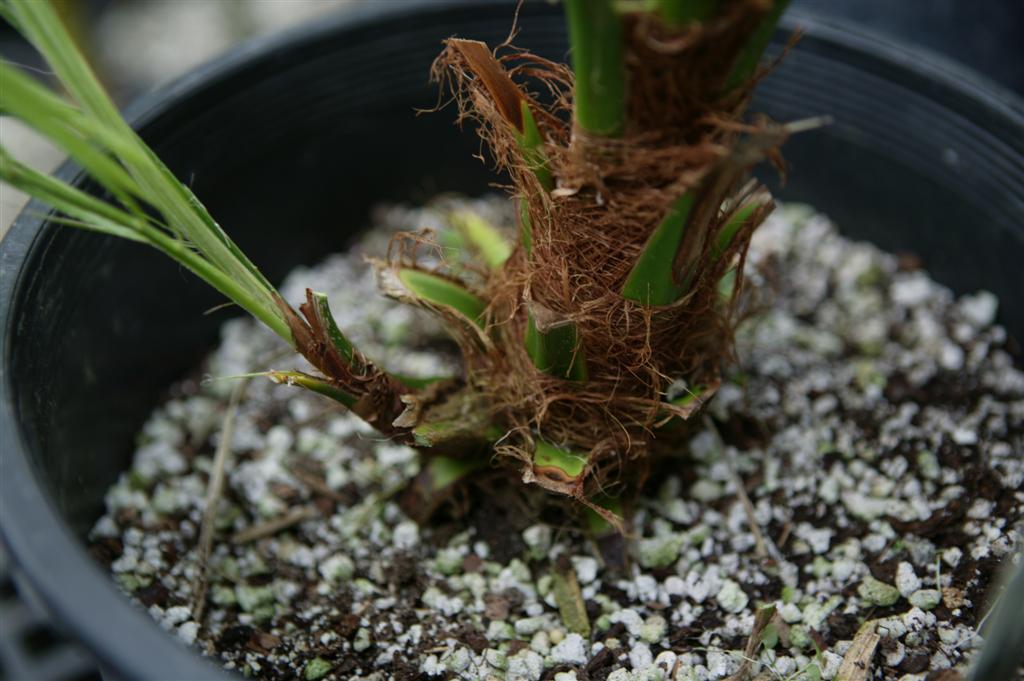
Compare the growth habit above to two single trunk Pygmy Date young plants that were grown, side by side, in one pot (below). Both appear similar, but careful examination shows that the two trunks below are not attached but rather just side by side. The plant above is a naturally suckering plant from Laos. Below are separate, individually planted plants. Below is what you see in most nurseries, although the number of plants per pot does vary.

In summary,99.5% of Pygmy Dates grown in the U.S. are single trunk yet sometimes planted as “multiples”. Yet, in the wild in Asia, they are quite often suckering plants. And, if you get seeds from your female Pygmy Date and didn’t control pollination, the chances are you will get a hybrid and it may sucker. But, it won’t appear quite like plants from the wild.
PECULIAR FORMS OF PHOENIX ROEBELENII
When one grows palms for quite a while, one sees unusual things. There are forms of a plant called “crested” (or showing fasciation) which have, for some unknown reason, the appearance of multiple growth points at the top of the stem. There is another thing called “monstrose” where a single trunk plant begins to fork and divide for no apparent reason. Sometimes a crested form can change into the montrose form. Pygmy Date Palms have shown both of these peculiar variations. Interestingly enough, when a plant develops one of these “abnormalities”, it actually becomes more valuable to some collectors. This is because it is rare. The pictures below show what appears to be a crested Pygmy Date Palm. This is seen with four plants in a single front yard. There is only speculation as to what caused this. Some feel it could be genetic, others say it’s environmental. Environmental factors might include chemicals, infections, disease, etc. Pauleen Sullivan in Ventura, CA tells a story about how her husband grew several hundred Pygmy Dates and about ten to twenty years later these palms all began branching at the same time and at various locations. This would suggest something genetic as they were all sold and went to various areas of Southern California. I mention this abnormality because you may see them as you look around at palms.

crested crown of leaves

how multiple growth heads are emerging.
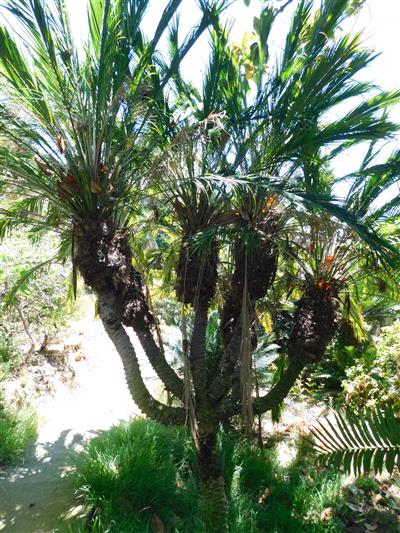
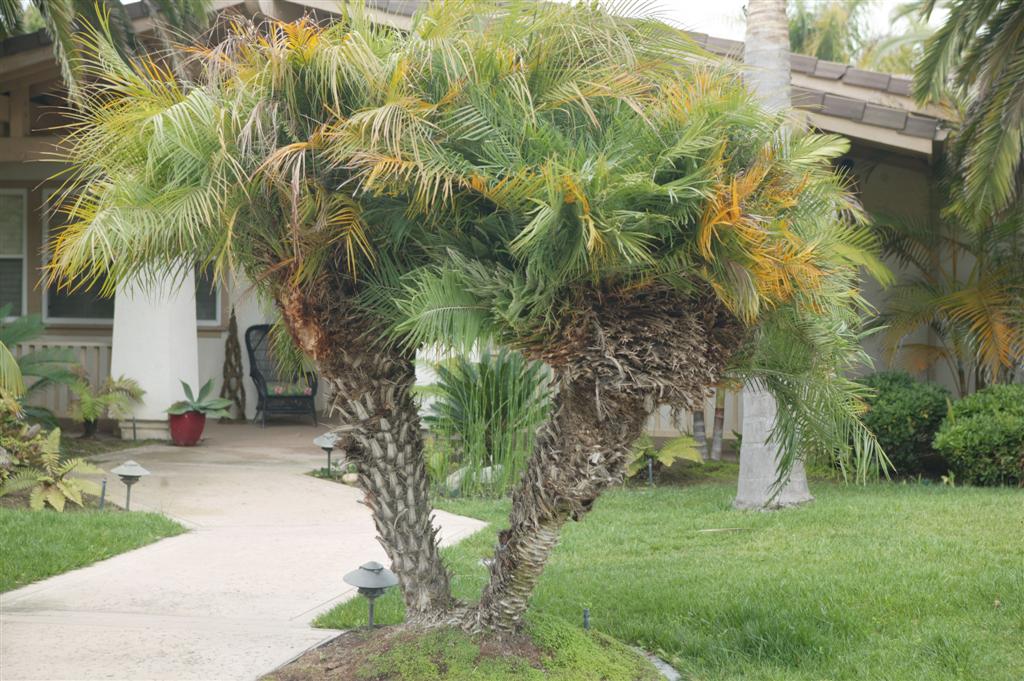

branching of the trunk
DIGGING AND TRANSPLANTING THE PYGMY DATE PALM
Even though many large Phoenix specimens are successfully dug and replanted elsewhere, digging and moving a Pygmy Date Palm is many times difficult. This is probably the result of the viewpoint that they are small and therefore a man or two can dig them up and move them. Statistically, most dug Pygmy Dates don’t make it. This could be a combination of the species dislike for being transplanted and too small of a root ball. If you have a good sized Pygmy and want to move it, get a root ball that is enormous; one that takes three or four men to lift and move. Otherwise, you probably will be wasting your time. A crane transferred root ball would be preferred for all but the smallest of plants. If a dug Pygmy Date Palm is having difficulty, you will first see trouble with the newest leaves or speared. After digging, a Pygmy Date’s shock is evident by the dug plants failure to open up new leaves. Such a plant can show four to five new spears, none of which has opened. Leaves may appear limp and hang downwards. Or, they may show decline with a brown or dead color. The plant below shows limp, drooping leaves probably the result of a transplant.

Pygmy Date Palm
PRUNING OF THE PYGMY DATE PALM
Basically, pruning a Phoenix roebelenii is similar to pruning other types of palm trees with the exception that protective eyewear should be used on any palm with spines. And, the Pygmy Date Palm definitely has some nasty spines. They are not huge but can hurt you or injure your eye if you are not protected. When removing leaves, start at the bottom of the crown of leaves and remove the lowest leaves that have turned brown and are ugly. Removing green leaves results in loss of chlorophyll or plant energy. Remove one leaf at a time and work your way up to healthy looking leaves and stop there. Be careful when putting leaves in the trash as the spines have a way of whipping around and hitting you.
You can also tidy up the trunk of the Dwarf Date Palm. This is referred to above. One can remove the old leaf debris and fibers down to the actual woody trunk. This will result in the “knobs” of the trunk being visible. Such a pruned trunk is quite appealing and interesting. Similar but larger appearances are seen on other species such as the True Date Palm, Phoenix dactylifera. Also, when one cleans the trunk up to the top where the most recently removed leaves are more adherent, one can make a “pineapple” just like they do with the Canary Island Date Palm.
If no pruning is done whatsoever, old leaves will hang down near the trunk and, over time, the plant will become very unsightly and more prone to disease. Fusarium infections, which afflict the Phoenix canariensis would be most rare with the Pygmy Date Palm. In any case, cleaning of pruning equipment prior to trimming the tree might be in order.
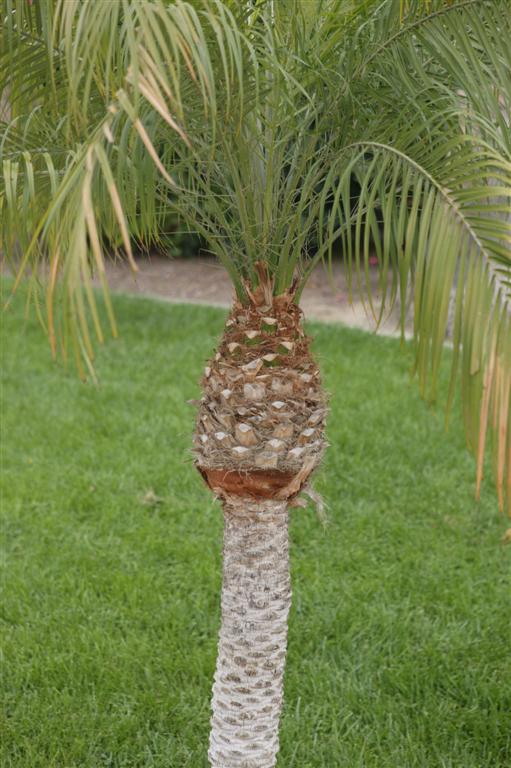
that has been cleaned to show
a “pinapple top”
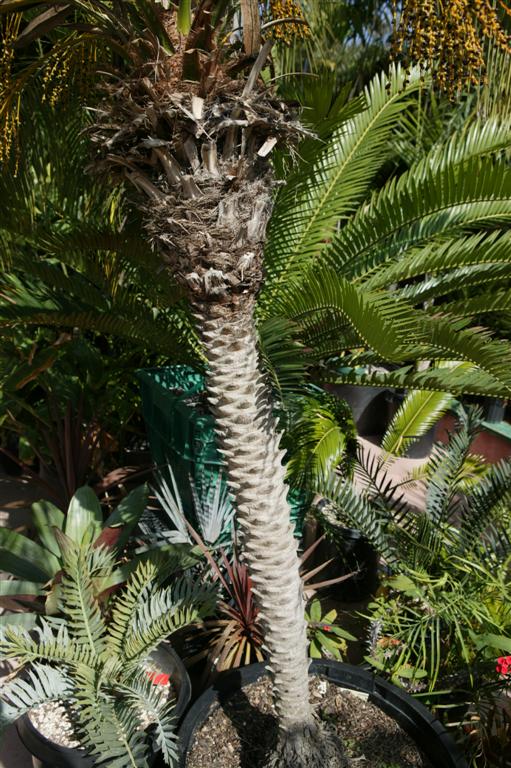
knobby trunk
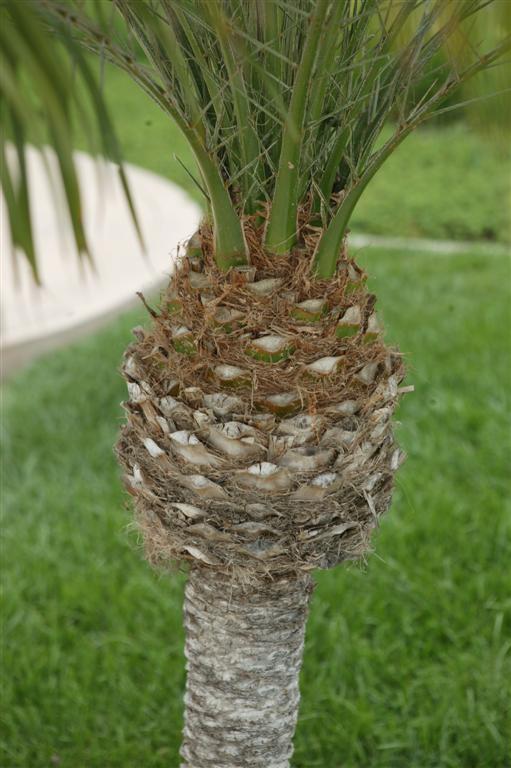
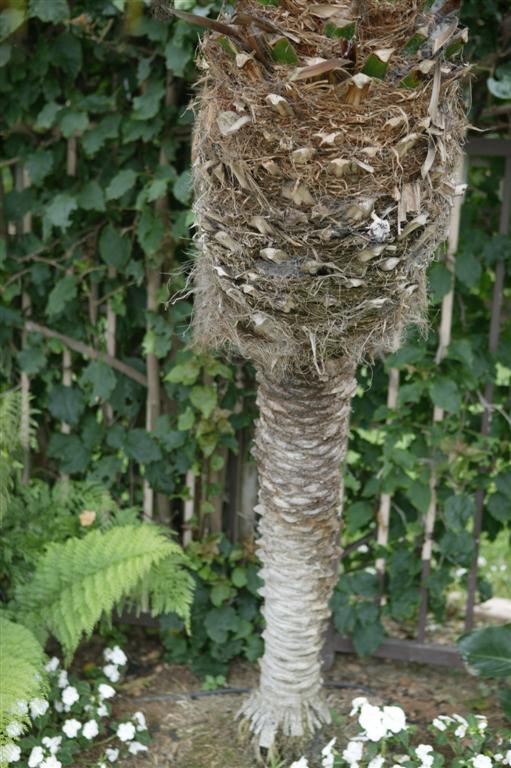
cleaned Pygmy Date Palm
PESTS ON PYGMY DATE PALMS
Phoenix roebelenii are usually considered a near pest free species. However, insect pests can infect them. Most common would be some form of scale. This is a small, dome shaped insect that is quite easy to recognize. These pests suck nutrition from the plant. Other pests to watch for would include mealy bug and aphids. Crawling large insects such as weevils and grasshoppers have been known to feed on the Pygmy Date Palms. All of these insects can be controlled with insecticides or beneficial predator insects/animals. Sometimes bad looking leaves are secondary to nutritional deficiencies. If you see no insects and yellow spots on the leaves, try giving some fertilizer or microelements.
SUMMARY COMMENTS ON THE PYGMY DATE PALM
The Pygmy Date Palm or Dwarf Date Palm, Latin name Phoenix roebelenii, is a very popular single trunk palm that is most often sold as multiple plants in the same pot. However, in the wild, it often suckers naturally. It is also called the Dwarf Date Palm and often (misspelled) as the roebelenii palm. This is a somewhat small palm, usually not getting over ten feet in overall height. The leaves are glossy green and leaf stems are armed with spines. Protective eye ware should be used when pruning. Growth is fairly easy. This species prefers full sun unless one is in a harsh desert environment where filtered light might be optimal. Average water is needed. Like other types of Phoenix, the Pygmy Date Palm will hybridize with other species giving a whole array of different appearing offspring. Male and female plants are needed to set fertile seeds. Typically plants are fairly pest free and pruning can accentuate the “knobby trunk” or be pruned to show a miniature “pineapple” below the leaves. Like all palms, the Pygmy Date Palm needs fertilizer and microelements or leaves may begin to look bad.
Thanks for reading this. As you may have noticed, we have lots of interesting articles at our site on palm trees and cycads. Hit “Home” to see the list of more articles to review.
Phil Bergman
Owner
- PALM TREES, CYCADS & TROPICAL PLANT BLOG - October 1, 2020
- TRACHYCARPUS
The Windmill Palm - September 30, 2020 - FAN PALMS –
PALMS WITH CIRCULAR LEAVES - September 29, 2020












